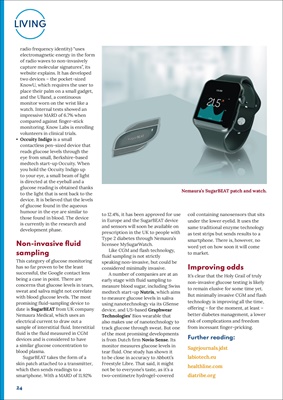
24
LIVING
ultrasonic, electromagnetic and
thermal technologies to measure
three distinct criteria to provide
a glucose measurement". It uses
a unique algorithm to analyse the
result, which is displayed on a handheld device
the size of a smartphone.
The non-invasive sensors last six
months but have to be used in
temperatures between 15°C and
35°C. The MARD is not exactly
Dexcom standard either - 17.5% to
19.7%, and is not designed to be worn
continuously.
In addition, there are a number
of interesting and innovative noninvasive
optical sensor developments
in the pipeline:
• Afon Technology, a Welsh
start-up, is using a technology
called microwave spectroscopy.
Spectroscopy is the study of
the interaction of matter and
electromagnetic radiation,
commonly used in blood tests and
medical imaging. Afon employs
radio and microwave frequencies
(multi-resonance), which are both
on the long wavelength end of
the Electromagnetic Spectrum,
to read blood glucose levels via
a non-invasive sensor. This sits
on the inside of your wrist and
communicates via Bluetooth with
your smart device, perhaps even
the smartwatch you can wear over
it. MHRA-approved clinical trials
have begun at the Joint Clinical
Research Facility (JCRF) at Swansea
University. As Afon CEO Sabih
Choudhry reports, "In-house
testing has yielded average MARDs
of 11% to 12%, but we expect to
improve these further with the
implementation of AI and deep
machine learning algorithms."
The plan is to start the regulatory
approval process in late 2023 or
early 2024.
• DiaMondTech, a German biotech
firm, is developing three different
gadgets, the D-Base (a shoeboxsized
device for clinical settings),
the D-Pocket (a hand-held device
you press for a glucose reading,
which could be ready shortly) and
D-Sensor (a bracelet incorporating
a sensor). The technology is
photothermal detection - a beam
of light is directed through the
skin, where glucose converts the
light to heat and blood glucose
levels are then measured based on
the change in temperature. The
D-Base is showing as only slightly
less accurate than Dexcom sensors,
with a MARD of 11.3% to 12.1%,
though low or high atmospheric
or skin temperatures could give
inexact readings.
• GlucoWise was originally
developed by UK company
Mediwise, which is now part
of Canadian smart materials
and phototonics specialist
Metamaterials. It is a small monitor
held on the skin that lies between
the thumb and forefinger. Lowpower
radio waves cross the skin,
helped by a special film technology
which prevents the skin blocking
the waves, in order to measure
blood glucose levels. Readings
are delivered to a smartphone
app. Much heralded but still
not available, the GlucoWise
is undergoing human trials to
determine accuracy.
• GWave from Hagar, an Israeli startup, measures
glucose in the blood
continuously and in real time using
radio frequency waves. The firstgeneration
GWave sensor is about
a third of the size of an average
smartphone and is contained in a
ceramic bracelet, but the firm has
recently secured funds to develop
a second-generation device, which
will be housed in a smartwatch.
Hagar claims its monitor is 95%
accurate compared to an off-theshelf pin-prick device.
• Know Labs in Seattle combines
spectroscopy and radio waves
to detect glucose levels noninvasively
in the blood at any given
time. Its patented Bio-RFID (body
Glucowise device..
Libre 3 and app.